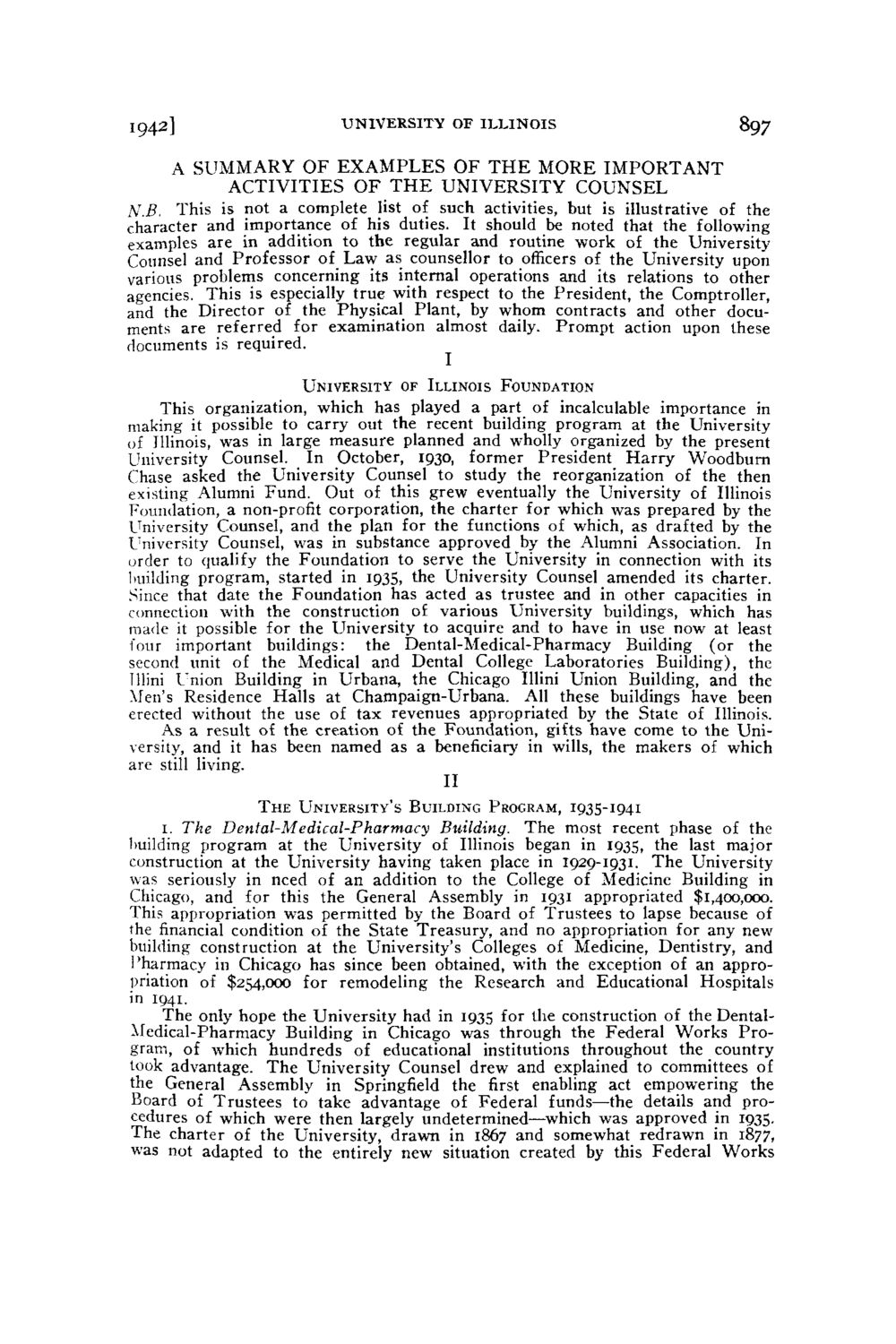| |
| |
Caption: Board of Trustees Minutes - 1942
This is a reduced-resolution page image for fast online browsing.

EXTRACTED TEXT FROM PAGE:
1942] UNIVERSITY OF ILLINOIS 897 A SUMMARY OF EXAMPLES OF T H E MORE IMPORTANT ACTIVITIES O F T H E UNIVERSITY COUNSEL N.B, This is not a complete list of such activities, but is illustrative of the character and importance of his duties. It should be noted that the following examples are in addition to the regular and routine work of the University Counsel and Professor of Law as counsellor to officers of the University upon various problems concerning its internal operations and its relations to other agencies. This is especially true with respect to the President, the Comptroller, and the Director of the Physical Plant, by whom contracts and other documents are referred for examination almost daily. Prompt action upon these documents is required. I UNIVERSITY OF ILLINOIS FOUNDATION This organization, which has played a part of incalculable importance in making it possible to carry out the recent building program at the University of Illinois, was in large measure planned and wholly organized by the present University Counsel. In October, 1930, former President H a r r y Woodburn Chase asked the University Counsel to study the reorganization of the then existing Alumni Fund. Out of this grew eventually the University of Illinois Foundation, a non-profit corporation, the charter for which was prepared by the University Counsel, and the plan for the functions of which, as drafted by the University Counsel, was in substance approved by the Alumni Association. In order to qualify the Foundation to serve the University in connection with its building program, started in 1935, the University Counsel amended its charter. Since that date the Foundation has acted as trustee and in other capacities in connection with the construction of various University buildings, which has made it possible for the University to acquire and to have in use now at least four important buildings: the Dental-Medical-Pharmacy Building (or the second unit of the Medical and Dental College Laboratories Building), the lllini Union Building in Urbana, the Chicago Mini Union Building, and the Men's Residence Halls at Champaign-Urbana. All these buildings have been erected without the use of tax revenues appropriated by the State of Illinois. As a result of the creation of the Foundation, gifts have come to the University, and it has been named as a beneficiary in wills, the makers of which are still living. II T H E UNIVERSITY'S BUILDING PROGRAM, 1935-1941 1. The Dental-Medical-Pharmacy Building. The most recent phase of the building program at the University of Illinois began in 1935, the last major construction at the University having taken place in 1929-1931. T h e University was seriously in need of an addition to the College of Medicine Building in Chicago, and for this the General Assembly in 1931 appropriated $1,400,000. This appropriation was permitted by the Board of Trustees to lapse because of the financial condition of the State Treasury, and no appropriation for any new building construction at the University's Colleges of Medicine, Dentistry, and Pharmacy in Chicago has since been obtained, with the exception of an appropriation of $254,000 for remodeling the Research and Educational Hospitals in 1941. The only hope the University had in 1935 for the construction of the DentalMedical-Pharmacy Building in Chicago was through the Federal Works P r o gram, of which hundreds of educational institutions throughout the country took advantage. T h e University Counsel drew and explained to committees of the General Assembly in Springfield the first enabling act empowering the Board of Trustees to take advantage of Federal funds—the details and procedures of which were then largely undetermined—which was approved in 1935. The charter of the University, drawn in 1867 and somewhat redrawn in 1877, was not adapted to the entirely new situation created by this Federal Works
| |